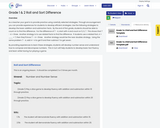
Operations with Integers Subtraction Algebra Readiness Remediation Plan
- Subject:
- Mathematics
- Material Type:
- Lesson Plan
- Provider:
- VDOE
- Author:
- VDOE
- Date Added:
- 10/07/2024

Operations with Integers Subtraction Algebra Readiness Remediation Plan

Students will analyze a provided math problem with an incorrect answer (bug). Students will demonstrate their understanding of the process by identifying the error, solving the problem correctly and providing an explanation. Math problem solving directly correlates with the step by step process that computer science debugging requires. The purpose of this experience is to provide a jumping off point for a deeper understanding of the Computer Science SOLs. This could be the first time your students are exposed to the vocabulary (algorithm, bug, debugging) and can provide a good foundation of the understanding of the vocabulary in a concrete, low-technology way.

Adding and subtracting fractions using context as a tool to support student understanding Mathematics Instructional Plans (MIPs) help teachers align instruction with the 2016 Mathematics Standards of Learning (SOL) by providing examples of how the knowledge, skills and processes found in the SOL and curriculum framework can be presented to students in the classroom.

This video is part of the Continue to Know with WHRO TV series. Watch Emily Rathbone teach about comprehending word problems using whole numbers.

This video is part of the Learn and Grow with WHRO TV series. Watch Xenia Claire teach about adding and subtracting with practical problems using a variety of strategies.

Adding and subtracting decimals, through the thousandths, used in contextual situations. Mathematics Instructional Plans (MIPs) help teachers align instruction with the 2016 Mathematics Standards of Learning (SOL) by providing examples of how the knowledge, skills and processes found in the SOL and curriculum framework can be presented to students in the classroom.

This video is part of the Learn and Grow with WHRO TV series. Watch Shantel Davis teach addition and subtraction strategies.

This video is part of the Continue to Know with WHRO TV series. Watch Emily Rathbone teach about estimating and solving multistep word problems using whole numbers.

Adding and subtracting fractions and mixed numbers Mathematics Instructional Plans (MIPs) help teachers align instruction with the Mathematics Standards of Learning (SOL) by providing examples of how the knowledge, skills and processes found in the SOL and curriculum framework can be presented to students in the classroom.

Using fractions strips to model the concept of subtracting fractions. Mathematics Instructional Plans (MIPs) help teachers align instruction with the Mathematics Standards of Learning (SOL) by providing examples of how the knowledge, skills and processes found in the SOL and curriculum framework can be presented to students in the classroom.

As a teacher your goal is to provide practice using carefully selected strategies. Through encouragement you can provide experiences for students to develop efficient strategies. Use the following strategies to develop the basic addition and subtraction facts. By the end of first grade, students should be able to count on to find the difference. For the difference of 7 - 4, start with 4 and count on 5, 6, 7. This shows that 7 - 4 = three. Another strategy is to use related facts to find the difference. If students use a related fact, 4 + ___ = 7, then they’ll know 7 – 4 = three. Another strategy would be the near doubles strategy. Using the same problem 7 - 4, add 4 + 4 to get 8 and then subtract 1 to get seven.By providing experiences to learn these strategies, students will develop number sense and understand how to compose and decompose numbers. This in turn will help students to develop basic fact fluency and learn while having fun playing a game.

In the first unit of Grade 3, students will build on their understanding of the structure of the place value system from Grade 2 (MP.7), start to use rounding as a way to estimate quantities (3.NBT.1), as well as develop fluency with the standard algorithm of addition and subtraction (3.NBT.2). Throughout the unit, students attend to the precision of their calculations (MP.6) and use them to solve real-world problems (MP.4).
In Grade 2, students developed an understanding of the structure of the base-ten system as based in repeated bundling in groups of 10. With this deepened understanding of the place value system, Grade 2 students “add and subtract within 1000, with composing and decomposing, and they understand and explain the reasoning of the processes they use” (NBT Progressions, p. 8). These processes and strategies include concrete models or drawings and strategies based on place value, properties of operations, and/or the relationship between addition and subtraction (2.NBT.7). As such, at the end of Grade 2, students are able to add and subtract within 1,000 but often aren’t relying on the standard algorithm to solve.
Thus, Unit 1 starts off with reinforcing some of this place value understanding of thousands, hundreds, tens, and ones being made up of 10 of the unit to its right that students learned in Grade 2. Students use this sense of magnitude and the idea of benchmark numbers to first place numbers on number lines of various endpoints and intervals, and next use those number lines as a model to help students round two-digit numbers to the tens place as well as three-digit numbers to the hundreds and tens place (3.NBT.1). Next, students focus on developing their fluency with the addition and subtraction algorithms up to 1,000, making connections to the place value understandings and other models they learned in Grade 2 (3.NBT.2). Last, the unit culminates in a synthesis of all learning thus far in the unit, in which students solve one- and two-step word problems involving addition and subtraction and use rounding to assess the reasonableness of their answer (3.OA.8), connecting the NBT and OA domains. These skills are developed further and built upon in subsequent units in which multiplication and division are added to the types of word problems students estimate and solve.

In the first unit for Grade 4, students extend their work with whole numbers and use this generalized understanding of the place value system in the context of comparing numbers, rounding them, and adding and subtracting them.
Students understanding of the base ten system begins as early as Kindergarten, when students learn to decompose teen numbers as ten ones and some ones (K.NBT.1). This understanding continues to develop in Grade 1, when students learn that ten is a unit and therefore decompose teen numbers into one ten (as opposed to ten ones) and some ones and learn that the decade numbers can be referred to as some tens (1.NBT.1). Students also start to compare two-digit numbers (1.NBT.2) and add and subtract within 100 based on place value (1.NBT.3—5). In second grade, students generalize the place value system even further, understanding one hundred as a unit (2.NBT.1) and comparing, adding, and subtracting numbers within 1,000 (2.NBT.2—9). In Grade 3, place value (NBT) standards are additional cluster content, but they still spend time fluently adding and subtracting within 1,000 and rounding three-digit numbers to the nearest 10 and 100 (3.NBT.1—2).
Thus, because students did not focus heavily on place value in Grade 3, Unit 1 begins with where things left off in Grade 2 of understanding numbers within 1,000. Students get a sense of the magnitude of each place value by visually representing the place values they are already familiar with and building from there. Once students have a visual and conceptual sense of the “ten times greater” property, they are able to articulate why a digit in any place represents 10 times as much as it represents in the place to its right (4.NBT.1). Next, students write multi-digit numbers in various forms and compare them (4.NBT.2). Comparison leads directly into rounding, where Grade 4 students learn to round to any place value (4.NBT.3). Next, students use the standard algorithms for addition and subtraction with multi-digit numbers (4.NBT.4) and apply their algorithmic knowledge to solve word problems. The unit culminates with multi-step word problems involving addition and subtraction, using a letter to represent the unknown quantity, then using rounding to assess the reasonableness of their answer (4.OA.3), allowing for students to connect content across different clusters and domains (4.NBT.A, 4.NBT.B, and 4.OA.B).
Throughout the unit, students will repeatedly look for and make use of structure, specifically the structure of the place value system (MP.7). Students develop an understanding that a digit in any place represents 10 times as much as it represents in the place to its right, then apply that understanding of structure to compare, round, and add and subtract multi-digit whole numbers

This video is part of the Learn and Grow with WHRO TV series. Watch Dr. Deborah Fuge teach about solving word problems.

Just in Time Quick Check Addition and Subtraction Practical Problems

Just in Time Quick Check Addition and Subtraction Fluency

Just in Time Quick Check Estimate Sums and Differences

Just in Time Quick Check Determine Sums and Differences

Developing basic addition and subtraction fact strategies for “make ten”Mathematics Instructional Plans (MIPs) help teachers align instruction with the Mathematics Standards of Learning (SOL) by providing examples of how the knowledge, skills and processes found in the SOL and curriculum framework can be presented to students in the classroom.

This video is part of the Learn and Grow with WHRO TV series. Watch Meghan Dmytriw teach about how to solve multi-step word problems.